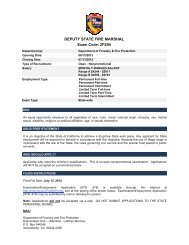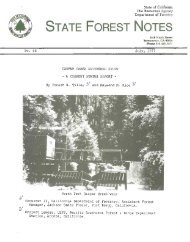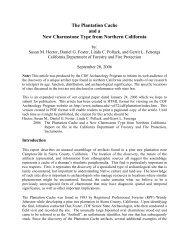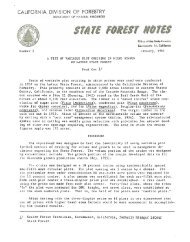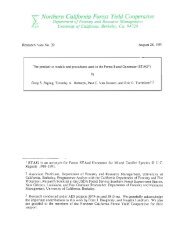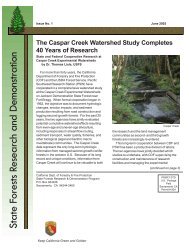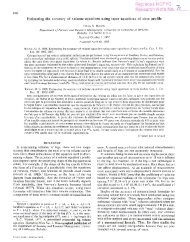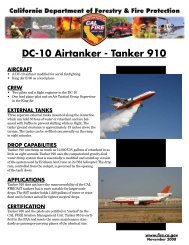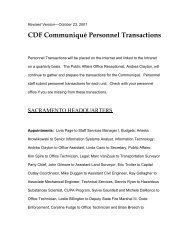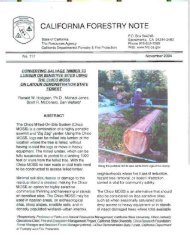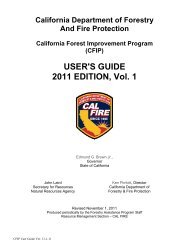Create successful ePaper yourself
Turn your PDF publications into a flip-book with our unique Google optimized e-Paper software.
Red Hill Fuelbreak<br />
2005 Riverside <strong>Unit</strong> Pre-Fire Management Plan<br />
The unincorporated community <strong>of</strong> Pine Cove, located in the San Jacinto Mountains<br />
<strong>of</strong> Riverside County, has a population <strong>of</strong> approximately 1500 permanent residents<br />
on 2200 improved parcels. Pine Cove is situated predominately on a<br />
western/southwest aspect <strong>of</strong> the San Jacinto Mountain range at 6200’ elevation and<br />
is “mid-slope” between the San Jacinto Valley to the west at 1700’ in elevation and<br />
San Jacinto Peak at 10,804’ in elevation to the east. Lands owned and protected by<br />
the U.S.D.A. Forest Service/San Bernardino National Forest surround the<br />
community <strong>of</strong> Pine Cove.<br />
The vegetative community is comprised <strong>of</strong> mature chaparral with a mixed conifer<br />
forest over story. The predominant under story species include manzanita,<br />
chaparral whitethorn, deer brush and chamise. The tree over story consists <strong>of</strong><br />
mixed stands <strong>of</strong> Jeffery Pine, Ponderosa Pine, Coulter Pine, Incense Cedar, White<br />
Fire and Sugar Pine. There is no recorded fire history for the area since fire records<br />
started being kept around 1924; therefore it is assumed the vegetative community is<br />
at least 75 years old.<br />
In 1991, the <strong>California</strong> Department <strong>of</strong> Forestry and Fire Protection (CDF) entered<br />
into a Vegetation Management Program (VMP) Agreement with 34 private property<br />
owners on the western border <strong>of</strong> Pine Cove. The intent <strong>of</strong> the project was to reduce<br />
the fuel loading along the western perimeter <strong>of</strong> the community and to provide a<br />
“shaded fuelbreak” to protect the community from a potentially devastating slope<br />
driven wildland fire from the west. The CDF completed the project as defined in the<br />
1991 Agreements in November 1997.<br />
The Riverside <strong>Unit</strong> has re-entered into agreements with the current private property<br />
owners whose properties lie within the 1991 Red Hill Vegetation Management<br />
Program. In addition to maintaining the prescribed fuel loading levels completed<br />
during the 1991-1997 Program, it is proposed that CDF increases the treatment area<br />
within the same private properties to broaden the “shaded fuelbreak” and create a<br />
wider buffer <strong>of</strong> protection. The actual width <strong>of</strong> the treated area will vary depending<br />
on the type <strong>of</strong> vegetation and topography. The proposed fuel reduction project will<br />
be completed by piling dead vegetation, thinning brush and small trees with<br />
chainsaws and placing this material into small piles to be burned in cool weather.<br />
The net treatment area is approximately 251 acres.<br />
This fuel reduction project is part <strong>of</strong> a larger plan to tie several fuel treatment<br />
projects together and thus provide a continuous fuel modification zone along the<br />
western edge <strong>of</strong> the San Jacinto Mountain communities<br />
The proposed project has the potential <strong>of</strong> reducing the damages from wildland fires<br />
spreading into the community <strong>of</strong> Pine Cove. Fire history records indicate that fires in<br />
the surrounding area are traditionally slope and wind driven, burning in an easterly<br />
35




